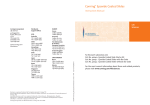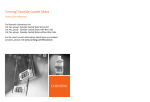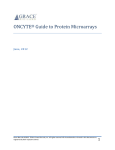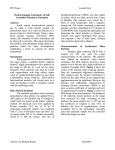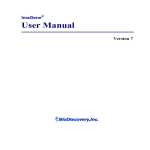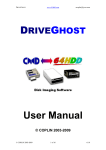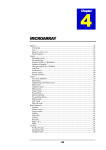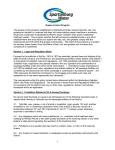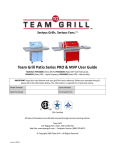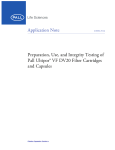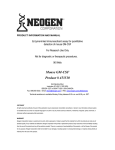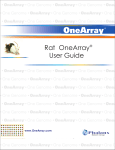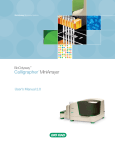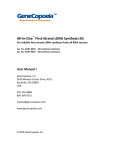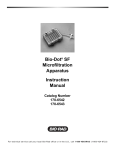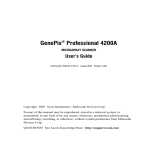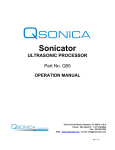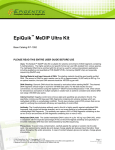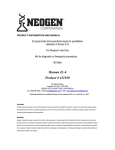Download UltraGAPS™ Coated Slides Instruction Manual with Protocols
Transcript
UltraGAPS™ Coated Slides Instruction Manual Life Sciences For Research Use Cat. No. 40015: UltraGAPS Slides with Bar Code Cat. No. 40016: UltraGAPS Slides without Bar Code Cat. No. 40017: UltraGAPS Slides with Bar Code – Bulk Pack Cat. No. 40018: UltraGAPS Slides without Bar Code – Bulk Pack Cat. No. 40019: UltraGAPS Slide Starter Kit For the most current information about these and related products, please visit www.corning.com/lifesciences. Rev. Jun. 2005 CONTENTS INTRODUCTION Introduction . . . . . . . . . . . . . . . . . . . . . . . . . . . . . . . . . . . 1 Overview Corning® UltraGAPS™ Coated Slides are the substrate of choice for fabricating DNA microarrays of the highest and most consistent quality. UltraGAPS Coated Slides are recommended for the fabrication of arrays of double-stranded DNA, such as purified PCR products, long oligonucleotides, and when substrate stability and consistency are absolute requirements. UltraGAPS Coated Slides have a uniform, covalently bound coating of pure Gamma Amino Propyl Silane (GAPS). The GAPS coating is applied to both sides of the slides using a proprietary process under tightly controlled manufacturing conditions. UltraGAPS slides offer a printing surface of unmatched cleanliness, high DNA-binding capacity, uniformity, and stability. Overview . . . . . . . . . . . . . . . . . . . . . . . . . . . . . . . . . . . . . 1 Handling and Care Instructions . . . . . . . . . . . . . . . . . . 2 Storage Instructions . . . . . . . . . . . . . . . . . . . . . . . . . . . . 2 Safety Considerations . . . . . . . . . . . . . . . . . . . . . . . . . . . 2 Product Use Limitations, Warranty, Disclaimer . . . . . 3 Preparation and Hybridization of DNA Microarrays . . 4 General Considerations . . . . . . . . . . . . . . . . . . . . . . . . . 4 Array Fabrication and Stabilization . . . . . . . . . . . . . . . . 7 Array Hybridization . . . . . . . . . . . . . . . . . . . . . . . . . . . 9 Microarray quality is highly dependent on the quality and integrity of the printing substrate. Arrays printed on coated glass of poor quality are likely to produce spots of varying size, shape, and DNA content. The presence of scratches, haze, and contaminating particulates on the slide surface also cause deformation of the arrays as well as high background fluorescence. These problems lead to loss in sensitivity and generally poor results. Preparation of Hybridization Solution . . . . . . . . . . . . . 9 Pre-Hybridization . . . . . . . . . . . . . . . . . . . . . . . . . . . . 12 Hybridization . . . . . . . . . . . . . . . . . . . . . . . . . . . . . . . . 12 Post-Hybridization Washes . . . . . . . . . . . . . . . . . . . . . 13 Additional Information . . . . . . . . . . . . . . . . . . . . . . . . . 14 UltraGAPS Coated Slides are manufactured under the most stringent conditions to prevent these problems. All slides are cleaned and individually examined for mechanical defects and for the presence of dust and glass particles. GAPS is applied in an environmentally controlled, HEPA-filtered ISO Class 5 facility, resulting in coated slides with highly uniform surface properties and low intrinsic autofluorescence. Surface wetability is consistent across the slide surface to assure uniform spot size and shape and to avoid uncontrolled wicking or poor volume transfer during the printing process. Amine density is also uniform across the slide surface leading to consistent DNA retention across the printed array. The packaging has been developed to ensure compatibility with the GAPS coating and to maintain the appropriate storage environment. Customer Service and Technical Support . . . . . . . . . . 14 Corning® Microarray Products . . . . . . . . . . . . . . . . . . 15 1 mended standard operating procedures for any laboratory equipment used in your experiments. Read the Material Safety Data Sheet (MSDS) for appropriate handling of all products. MSDS is available upon request or can be downloaded from www.corning.com/lifesciences. Handling and Care Instructions To maximize the benefits of using Corning® premium substrates, please follow these recommendations: ◗ ◗ ◗ ◗ ◗ Use the slides in a clean environment. Particles falling onto the slide surface may cause defects in the printed array as well as nuclease contamination. Self-contained printing environments may be required to prevent such contamination. Avoid direct contact with the surface of the slide. Only the print pins and processing solutions should touch the print area to avoid contamination and abrasion of the coating. When using slides without bar codes, clearly mark the side to be printed using a glass-etching tool. If the package of slides has been inadvertently stored at temperatures lower than 20°C, allow it to come to ambient temperature (20 to 25°C) before opening. Otherwise, condensation may form on the slide surface, negatively affecting the uniformity of the coating. Open the pouch just prior to printing. Close the cap on the slide container as soon as possible after removing slides to maintain a closed environment for unused slides. Place the closed container in the pouch to protect the remaining slides and store them in a desiccator. Use the remaining slides within one week of opening the pack. Product Use Limitations, Warranty, Disclaimer Corning® UltraGAPS™ Coated Slides are sold for research purposes only and are not intended for resale. This product is not to be used in human diagnostics or for drug purposes, nor is it to be administered to humans in any way. This product contains chemicals that may be harmful if misused. Proper care should be exercised with this product to prevent human contact. Corning products are guaranteed to perform as described when used properly. Manufacturer liability is limited to the replacement of the product or a full refund. Any misuse of this product including failure to follow proper use protocols is the responsibility of the user, and Corning makes no warranty or guarantee under these circumstances. Certain arrays and/or methods of preparation, analysis or use may be covered by intellectual property rights held by others in certain countries. Use of this product is recommended only for applications for which the user has a license under proprietary rights of third parties or for technology for which a license is not required. Storage Instructions Corning’s products may be used in connection with the manufacture, use and/or analysis of oligonucleotide arrays under patents owned by Oxford Gene Technology Limited or related companies (“OGT”), but Corning does not have the right to pass on a license under any such patents. Therefore, before Corning’s products can be used in connection with the manufacture, use, or analysis of oligonucleotide arrays, the user should first check with OGT as to whether a license is necessary and if so, secure one. To inquire about a license under OGT’s oligonucleotide array patents, please contact [email protected]. For information about OGT, please visit its website at www.ogt.co.uk. Store UltraGAPS™ slides at ambient temperature in original undamaged packaging, and use slides by the date indicated on the label. Proceed as described in the Handling and Care Instructions after opening the package. Safety Considerations When working with the UltraGAPS slides, please follow all generally accepted laboratory safety guidelines. At a minimum, wear the appropriate personal protective equipment such as a lab coat, safety glasses, powder-free gloves, etc. Follow recom- 2 3 P R E PA R AT I O N A N D H Y B R I D I Z AT I O N O F D N A M I C R O A R R AY S General Considerations ◗ ◗ 4 Composition of spotting solution. The chemical and physical properties of the spotting solution greatly influence DNA retention, spot morphology, and hybridization efficiency. Corning recommends the use of the Pronto!™ Universal Spotting Solution (Cat. No. 40027) because of its low evaporation rate and nuclease-inhibiting properties. Solvent evaporation causes the concentration of DNA and other nonvolatile components of the spotting solution to rise, leading to time-dependent changes in spot quality, suboptimal array uniformity, and the eventual loss of the spotting solution. The most commonly used spotting solution, in order of decreasing physical stability, are: Pronto! Universal Spotting Solution, 50% DMSO, 3 x SSC supplemented with 1.5 M betaine, 150 mM sodium phosphate, and 3 x SSC. These solutions have successfully been used to fabricate DNA arrays on UltraGAPS™ slides. DNA dissolved in DMSOcontaining media may aggregate if solvent concentration exceeds 70%, which happens upon prolonged use of the source plates and freeze-thaw cycling. Aqueous SSC- and sodium phosphate-containing media have a tendency to salt out, which may cause quill pins to clog, and require reconstitution after each print run, which leads to noticeable variability in DNA concentration among source wells. Preparation of probe DNA. Double-stranded DNA for spotting on microarrays is generally obtained by amplification of cloned genomic DNA and cDNAs. It is important to purify the amplified fragments as the presence of primers and other components of the reaction mix may interfere with binding to the slide and produce background fluorescence upon hybridization. Be sure to use purification methods that do not contribute fluorescent materials. Only oligonucleotides of the highest quality should be used for microarraying. The optimal length of oligonucleotides to be arrayed on UltraGAPS slides for transcriptional profiling is 70 nucleotides. As the ◗ ◗ 5 GAPS-coated surface provides free amine groups for ionic attachment of the negatively charged phosphate groups of the DNA backbone, functionalization of the oligonucleotides with an amine or other reactive group is not necessary. Oligonucleotides with and without such modifications bind equally efficiently to the UltraGAPS™ substrate. Concentration of probe DNA. The high reactivity of UltraGAPS slides allows the use of dilute printing solutions. The optimal concentration needs to be determined empirically. When too little DNA is used, the DNA spots will not reach signal saturation levels, thus reducing the dynamic range of the array. Conversely, highly concentrated printing solutions can produce spots with “comet tails” and other forms of localized background. The concentration and purity of the DNA should be checked spectrophotometrically as well as electrophoretically. The recommended concentrations to use as a starting point for further optimization are 0.10 mg/mL when spotting dsDNA (e.g., PCR products, genomic DNA) and 0.50 mg/mL when spotting oligonucleotides. Printing conditions and pin quality. Follow the instructions provided by the manufacturer of arraying equipment and printing pins. Printing should be performed under controlled environmental conditions, where temperature and relative humidity can be maintained at about 25ºC and 45%, respectively. Pins should be selected according to their diameter and loading capacity, depending on the desired array density and the number of arrays to be printed. For example, quill pins of 50 microns in diameter can produce arrays containing over 50,000 features when used to spot DNA dissolved in highly hygroscopic spotting solution such as 50% DMSO and Pronto!™ Universal Spotting Solution. Pincontact time and the force with which the pin strikes the slide also affect spot size and morphology. Pins must be individually qualified before use. Pins that are broken or otherwise do not conform to specifications must be replaced. Printing and pin-washing steps should be optimized during a test run in preparation for array fabrication. ◗ ◗ ◗ 6 Immobilization procedures. Binding of DNA to the GAPScoated surface is enhanced by UV cross-linking and/or baking. These procedures work equally well for DNA molecules longer than 300 bp. Smaller DNA molecules and oligonucleotides are best immobilized by UV cross-linking. When baking, care should be taken regarding the cleanliness of the oven. Volatile organics can irreversibly contaminate the surface of the array leading to high backgrounds. Quality and composition of array-processing reagents. The accuracy and reproducibility of microarray results are highly dependent on the nature of the reagents used to process the arrays. Corning strongly recommends the use of the Pronto!™ Universal Hybridization Kit (Cat. No. 40026, 40028), which is specifically tuned to the market-leading Corning microarray substrates, and is meant to provide instant expertise and a standardized, trouble-free microarraying experience. The Pronto! system includes the Long Oligo/cDNA Hybridization Solution, which, as its name indicates, is formulated for hybridization to arrays of both long oligonucleotides and double-stranded DNA. The reagent formulations and processes described in this manual have historically performed well for arrays made on aminosilane-coated slides, but they significantly differ from those of the Pronto! Reagent System. When deciding which reagents to use, it is also important to consider that reagents made in the laboratory environment generally lack the stringently controlled consistency that characterizes the Pronto! Reagents. Background fluorescence. The sensitivity, specificity, and reproducibility of microarray hybridization are negatively affected by background fluorescence. Depending on their age, the storage conditions, and the purity of the biological material and other components of the spotting solution used, DNA microarrays may develop high levels of background fluorescence on and around the printed areas, decreasing the specificity of the hybridization signals. The occurrence of “spotted” fluorescence can be minimized by placing arrays in a Corning® 25 Slide Holder (Cat. No. 40081) and storing them in a Microarray Storage Pouch (Cat. No. 40086). This form of background fluorescence can be eliminated by processing the arrays with the presoaking reagents included in the Pronto!™ Universal Hybridization Kit (Cat. No. 40026, 40028). The spurious attachment of labeled DNA to the unprinted area of the slide causes high background that interferes with spot identification during data collection and limits the sensitivity and dynamic range of the array. Deactivating and/or blocking the unused surface of the slide greatly reduces the incidence of this form of background and can be achieved by processing the arrays with the presoaking and prehybridization reagents conveniently included in the Pronto! Universal Hybridization Kit. Background reduction reagents are also available separately (Cat. No. 40029) for use by printing facilities as the last step in the array manufacturing process prior to storage and distribution to end users. Array Fabrication and Stabilization It is crucially important to fully evaluate the performance of a particular spotting medium under conditions that are as close to working conditions as possible before committing large sets of probes to the formulation. Thorough and properly controlled print tests must be done in order to ensure that the desired spot density and array uniformity is achievable. Once probe DNA is dissolved in a spotting medium, it is very difficult to recover it for reconstitution in a different solvent. 1. Prepare source plates (sterile, nuclease-free 384-well storage plates are recommended; Cat. Nos. 3656 and 3672) by dissolving purified probe DNA in the spotting solution. ◗ For double-stranded DNA, prepare solutions containing between 0.10 and 0.20 mg/mL. ◗ For oligonucleotides, prepare solutions containing between 0.35 and 0.70 mg/mL (the molarity of a 0.5-mg/mL solution of unmodified 70-mers is 22 µM). 2. Set up arrayer and print slides according to manufacturer’s or laboratory protocol. Always handle slides by the corners and wear powder-free gloves. 7 3. Remove arrays from printing platform and place them in original slide container or Corning® 25 Slide Holder (Cat. No. 40081). Array Hybridization This instruction manual describes labeling parameters and hybridization protocols related to the use of arrays of amplified cDNA clones and arrays of oligonucleotides for measuring relative transcript abundance (transcriptional profiling) and studying chromosomal abnormalities (comparative genomic hybridization). 4. Incubate arrays in desiccator for 24 to 48 hours (vacuum desiccator works best). 5. (Optional; see note) Rehydrate spotted DNA by holding slide (array side down) over a bath of hot purified water (95 to 100°C) for approximately 5 seconds until condensation of the water vapor is observed across the slide. Snap dry array by placing it (array side up) on a hot plate for 2 seconds. For transcriptional profiling, we recommend the use of the Pronto!™ Plus Systems (Cat. Nos. 40055 and 40056 for direct labeling, and 40075 and 40076 for indirect labeling), which include reagents for RNA isolation, cDNA synthesis, and array hybridization. 6. Immobilize spotted DNA ◗ ◗ For double-stranded DNA, use a UV crosslinker to apply 150 to 300 mJ of UV energy. Alternatively, bake the arrays at 80°C for 2 to 4 hours. If baking, place arrays in lidded glass container and make sure oven is clean and free of volatile organics. Please refer to “Comparative Genomic Hybridization Using Corning® Products” (Application Report; www.corning.com/ lifesciences) for information about hybridization of arrays of BAC-derived double-stranded DNA. For oligonucleotides, use a UV crosslinker to apply 600 mJ of UV energy. Baking does not work well for oligonucleotide arrays. Preparation of Hybridization Solution The quality and purity of the template RNA and the resulting cDNA are critical factors for successful hybridizations. Determine the yield and purity of the template RNA by measuring absorbance at 260 and 280 nm and by gel analysis. Use only RNA showing a 260/280 ratio between 1.7 and 2.1. After synthesis and purification of the cyanine-labeled target cDNA, measure absorbance at 260, 550, and 650 nm. Best hybridization results are obtained with cDNA having a frequency of incorporation (FOI) of at least 20 labeled nucleotides per thousand. Using cDNA of lower FOI reduces the sensitivity of the assay. An FOI greater than 50 is indicative of incomplete removal of unincorporated labeled nucleotides. Determine the yield and label strength of target cDNA using the following formulae: 7. Place arrays in Corning 25 Slide Holder (Cat. No. 40081). Place holder containing arrays in Corning Microarray Storage Pouch (Cat. No. 40086) and heat-seal pouch. Hybridize arrays within 6 months of fabrication. Exchanging the regular atmospheric air for clean nitrogen gas helps prevent oxidation of spotted material and extends the shelf life of the arrays. Note: Rehydration and snap drying have historically been done to denature double-stranded DNA spotted in a non-denaturing medium and to evenly distribute the probe DNA within the spotted area. The efficacy of this treatment has not been conclusively demonstrated. If performing this step, utmost care must be taken not to overexpose the array to the hot plate, since doing so will affect the integrity of the spotted DNA and increase background. Do not place arrays in boiling water as this may result in a significant loss of probe DNA and delamination of the coating. 8 9 Amount of target DNA (ng) = A260 x 37 x total eluted volume (µL) 3. Calculate the amount of target DNA needed for each array. The fluorescence strength required to achieve high levels of sensitivity and broad dynamic range depends on the type of RNA used to synthesize the target cDNA: Labeled nucleotides incorporated (pmoles) = for Cy3®: A550 X total eluted volume / 0.15 for Cy5: A650 X total eluted volume / 0.25 For Cy®-cDNA made from mRNA, use an amount of target DNA containing 0.25 pmoles of Cy-nucleotides per microliter of hybridization solution, per dye. For example, to hybridize an area covered by one Corning® 22 x 22 mm cover glass (approximately 5 cm2), dissolve an amount of cDNA containing 3 pmoles of each Cy3- and Cy5-dNTP in 12 µL of hybridization solution. ◗ For Cy-cDNA made from total RNA, use an amount of target DNA containing 1.0 pmoles of Cy-nucleotides per microliter of hybridization solution, per dye. For example, to hybridize an area covered by one Corning 22 x 22 mm cover glass (approximately 5 cm2), dissolve an amount of cDNA containing 12 pmoles of each Cy3- and Cy5-dNTP in 12 µL of hybridization solution. ◗ For Cy-genomic DNA (CGH applications), use an amount of target DNA containing 1.0 pmoles of Cy-nucleotides per microliter of hybridization solution, per dye. For example, to hybridize an area covered by one Corning 22 x 22 mm cover glass (approximately 5 cm2), dissolve an amount of DNA containing 12 pmoles of each Cy3- and Cy5dNTP in 12 µL of hybridization solution. 4. Dissolve the appropriate amount of target DNA in the required volume of hybridization solution. ◗ FOI = Labeled nucleotides incorporated x 324.5 / amount of target DNA Note: When labeling genomic DNA, subtract the amount of template genomic DNA to calculate actual yield. Note: These equations were generated using the following constants: One A260 unit of single-stranded DNA = 37 µg/mL; extinction coefficient of Cy3 = 150,000 M-1cm-1 at 550 nm; extinction coefficient of Cy5 = 250,000 M-1cm-1 at 650 nm; average molar mass of dNTP = 324.5. 1. Prepare fresh hybridization solution consisting of: For arrays of long oligonucleotides, 20 to 35% formamide, 5 x SSC, 0.1% SDS, and 0.1 mg/mL of a nucleic-acid blocker such as sonicated salmon sperm DNA or calf thymus DNA ◗ For arrays of cDNA-derived double-stranded DNA, 35 to 50% formamide, 5 x SSC, 0.1% SDS, and 0.1 mg/mL of a nucleic-acid blocker such as sonicated salmon sperm DNA or calf thymus DNA 2. Determine the area of the slide to be exposed to the hybridization solution, and calculate the volume of hybridization solution needed for each array. When using Corning® Cover Glass (Cat. No. 2870-22, 2940-244, and 2940-246), apply 2.5 µL of hybridization solution per cm2 of surface area. When using a raised-edge coverslip, apply 3 µL per cm2. ◗ 10 5. Incubate the DNA hybridization solution at 95°C for 5 minutes. 6. Briefly centrifuge the cDNA hybridization solution to collect condensation, and allow it cool to room temperature. Do not place the solution on ice, as this will cause precipitation of some of the components. Protect the labeled DNA from over-exposure to light to minimize photobleaching. 11 2. Carefully pipette the target DNA onto the arrayed surface. Avoid touching the array with the pipette tip and introducing air bubbles. Carefully lower the cover glass onto the array. Avoid trapping air bubbles between the array and the cover glass. Small air bubbles that do form usually dissipate during hybridization. Transfer array-cover glass assembly to Corning® Hybridization Chamber II (Cat. No. 40080). Pre-Hybridization Prehybridization should be done immediately preceding the application of the target cDNA onto the arrays. This step has the purpose of blocking the unused surface of the slide and removing loosely bound probe DNA. It is recommended that all target DNAs be characterized prior to the start of prehybridization. The preparation of the hybridization solutions can be completed during the time arrays are being prehybridized. 3. Assemble the chamber as described in the Corning Microarray Hybridization Chamber Operating Instructions Manual. Keep the chambers right-side up and in a horizontal position at all times to prevent movement of the cover glass relative to the array. 1. Prepare prehybridization solution consisting of 5 x SSC, 0.1% SDS, and 0.1 mg/mL BSA. The volumes required to process a given number of arrays depends on type of glassware available. Use Coplin jars to simultaneously process up to 5 arrays using only 50 mL of buffer per step. 4. Submerge chamber-array assembly in a water bath or place in a hybridization oven kept at 42°C. 2. Warm prehybridization solution to 42°C. 5. Hybridize arrays at 42°C for 12 to 16 hours. 3. Immerse arrays in prehybridization solution and incubate at 42ºC for 45 to 60 minutes. Post-Hybridization Washes It is extremely important not to allow the arrays to dry out between washes, as this will result in high backgrounds. Multiple containers are needed to perform the washes in the most efficient manner. Have all containers and the volumes of washing solutions ready before starting the procedure. Note that steps 2 and 3 both require solutions prewarmed to 42°C. 4. Transfer prehybridized arrays to 0.1 x SSC and incubate at ambient temperature (22 to 25ºC) for 5 minutes. 5. Repeat Step 4. 6. Transfer arrays to purified water and incubate at ambient temperature for 30 seconds. 7. Dry arrays by blowing high-purity nitrogen over the array or by centrifugation at 1,600 rpm, for 2 minutes. Keep arrays in a dust-free environment while completing the preparation of the hybridization solution. 1. Disassemble the hybridization chambers. Hybridization 4. Transfer arrays to 0.1 x SSC, 0.1% SDS at room temperature for 5 minutes. 2. Immerse arrays in 2 x SSC, 0.1% SDS at 42°C until the coverslip moves freely away from the slide. 3. Transfer arrays to 2 x SSC, 0.1% SDS at 42°C for 5 minutes. 1. Wash the required number of pieces of Corning® Cover Glass (Cat. No. 2870-22, 2940-244, 2940-246) with nuclease-free water, followed by ethanol. Dry cover glass by blowing high purity compressed nitrogen or allow to air dry in a dust-free environment. 5. Repeat step 4. 6. Transfer arrays to 0.1 x SSC at room temperature for 1 minute. 7. Repeat Step 6 four times. 8. Rinse arrays in 0.01 x SSC for 10 seconds. 12 13 9. Dry arrays by blowing clean compressed nitrogen or by centrifugation at 1,600 x g for 2 minutes. 10. Store arrays in the Corning® 25 Slide Holder (Cat. No. 40081). Protect arrays from overexposure to light until ready to scan. Note: Arrays spotted on UltraGAPS™ slides can be hybridized at temperatures up to 65°C. The use of hybridization temperatures higher than 42°C, however, calls for changes in the composition of the hybridization and wash solutions described in this manual, such as exclusion of formamide, to properly adjust their stringency to the requirements of the application at hand. A D D I T I O N A L I N F O R M AT I O N Customer Service and Technical Support For a detailed troubleshooting guide, answers to frequently asked questions, and additional information about these and other products, please visit www.corning.com/lifesciences. For questions, further clarification about this protocol, and other technical issues and information not covered in this manual, please e-mail [email protected] or call 800.492.1110 (+1.978.635.2200 outside Canada and USA). 14 Corning® Microarray Products Cat. No. 40015 40016 40017 40018 Product Description Qty/Pk Qty/Cs UltraGAPS™ Coated Slides, with Bar Code 5 UltraGAPS Coated Slides, witout Bar Code 5 UltraGAPS Coated Slides, with Bar Code, Bulk Pack 25 UltraGAPS Coated Slides, without Bar Code, 25 Bulk Pack 40019 UltraGAPS Slide Starter Kit with 5 mL Universal 10 Spotting Solution 40024 Pronto!™ Universal Validation Kit 1 40026 Pronto! Universal Hybridization Kit – for 25 Arrays 1 40027 Pronto! Universal Spotting Solution – 250 mL 1 40029 Pronto! Background Reduction Kit – for 50 Arrays 1 40055 Pronto! Plus Direct System – for 25 Reactions 1 with RNA Isolation 40056 Pronto! Plus Direct System – for 25 Reactions 1 without RNA Isolation 40075 Pronto! Plus Indirect System – for 25 Reactions 1 with RNA Isolation 40076 Pronto! Plus Indirect System – for 25 Reactions 1 without RNA Isolation 40080 Hybridization Chamber II 1 40001 Hybridization Chamber O-rings 5 40081 Corning 25 Slide Mailer 20 40082 Corning 5 Slide Mailer 50 40085 Microarray Storage Pouch – for 5 Slides 50 40086 Miroarray Storage Pouch – for 25 Slides 50 2870-22 Corning Cover Glass, Square, 22 x 22 mm, 1 oz No. 11/2 2940-244 Corning Cover Glass, Rectangular, 24 x 40 mm, 1 oz No. 11/2 2940-246 Corning Cover Glass, Rectangular, 24 x 60 mm, 1 oz No. 11/2 15 25 25 25 25 10 1 1 1 1 1 1 1 1 5 5 20 50 50 50 10 packs 10 packs 10 packs Corning® Microarray Products (Continued) Cat. No. Product Description 3357 3656 3672 3099 96 Well V-bottom Polypropylene Microplate 384 Well Polypropylene Storage Microplate 384 Well Microarray Printing Plate, Low Volume Universal Lid – Rigid Lid for 96 and 384 Well Microplates Aluminum Sealing Tape for 384 Well Blocks and Microplates Aluminum Sealing Tape for 96 Well Blocks and Microplates DMSO Resistant Lid for 384 Well Microplates 6569 6570 3085 16 N OTE S Qty/Pk Qty/Cs 25 25 10 25 100 100 50 50 100 100 100 100 25 50 17 L AT I N A M E R I C A Brasil t (55-11) 3089-7420 f (55-11) 3167-0700 Mexico t (52-81) 8313-8586 f (52-81) 8313-8589 Corning is a registered trademark of Corning Incorporated, Corning, NY. Discovering Beyond Imagination and Flame of Discovery design are trademarks of Corning Incorporated, Corning, NY. UltraGAPS and Pronto! are trademarks of Corning Incorporated, Corning, NY. Cy is a registered trademark of Amersham plc, Buckinghamshire, England. LifterSlip is a trademark of Apogent, Portsmouth, NH. Corning Incorporated, One Riverfront Plaza, Corning, NY 14831-0001 CLS-GAPS-004REV2 www.corning.com/ lifesciences ASIA Australia t 61 2-9416-0492 f 61 2-9416-0493 China t 86 21-3222-4666 f 86 21-6288-1575 Hong Kong t 852-2807-2723 f 852-2807-2152 India t 91 11 341 3440 f 91 11 341 1520 Japan t 81 (0) 3-3586 1996 f 81 (0) 3-3586 1291 Korea t 82 2-796-9500 f 82 2-796-9300 Singapore t 65 6733-6511 f 65 6735-2913 Taiwan t 886 2-2716-0338 f 886 2-2716-0339 EUROPE France t 0800 916 882 f 31 20 659 7673 Germany t 0800 101 1153 f 0800 101 2427 The Netherlands & All Other European Countries t 31 (0) 20 655 79 28 f 31 (0) 20 659 76 73 United Kingdom t 0800 376 8660 f 0800 279 1117 8/05 BF 45 Nagog Park Acton, MA 01720 t 800.492.1110 t 978.635.2200 f 978.635.2476 Worldwide Support Offices © 2005 Corning Incorporated Printed in USA Corning Incorporated Life Sciences











